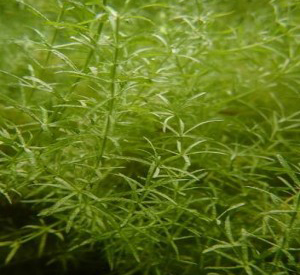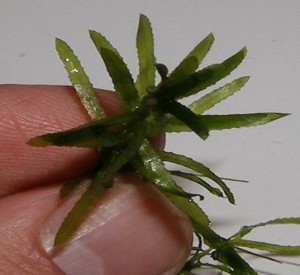About hydrilla
Hydrilla is a submerged, rooted, annual or perennial freshwater aquatic plant with slender stems that can grow up to the surface from crowns rooted in the substrate as deep as 9 m.
Leaves are 6 mm to 20 mm long, 2 mm to 4 mm wide and are strap-shaped with pointed tips and saw-tooth edges. They occur in opposite pairs, or typically in whorls of 4, although they may range from 3 to 8 and rarely 12 per whorl. Colour varies from green, translucent, yellowish, to brown.
Only male hydrilla are present in New Zealand and the main mode of reproduction and spread is via plant fragments. Hydrilla also produces specialised hibernating organs called tubers and turions. Turions live for only a couple of years but tubers can remain viable for up to 4 years overseas and possibly up to ten in New Zealand.
Why we don't want hydrilla in New Zealand
Hydrilla is a highly invasive water weed and is considered one of the world's worst submerged pest plants. The dense single species canopy formed by hydrilla displaces and excludes native vegetation particularly in the 1 metre to 5 metre water depth zone. The weed beds can also cause deoxygenation of the water with adverse impacts on animal life.
Hydrilla can cause significant economic losses through blocking water intakes and affecting power generation and irrigation. Weed beds of hydrilla are a nuisance to lake users such as bathers, anglers, and boaties. In shallow waterways it can restrict navigation and impede water flow in irrigation and drainage channels. Plant material washed ashore rots, reducing the aesthetic value of the lakes, and restricting access to water.
Where hydrilla has been found
Hydrilla was first detected in Lakes Tūtira and Waikōpiro in 1963 and later found in Lakes Opouahi and Eland, all in Hawke's Bay. It has not been found anywhere else in New Zealand. The last time hydrilla plants were seen in New Zealand was in Lake Tūtira in 2015.
The potential for hydrilla to establish in freshwater bodies in New Zealand is almost unlimited. All fresh waterways are at risk, including Lake Waikaremoana, Lake Taupō, the Rotorua lakes, and the South Island lakes and rivers.
Hydrilla eradication programme
Hydrilla is one of the species being eradicated through the National Interest Pest Responses programme.
The eradication programme currently uses grass carp as a biocontrol agent to ensure that any plants that grow are grazed on to prevent regrowth. Due to the longevity of the turions a site is monitored until it has been clear of plant material for 10 consecutive years to ensure eradication. Hydrilla has been successfully eradicated from 2 lakes and the programme is on track to eradicate this species from the remaining known sites.
Biosecurity New Zealand works closely with the regional councils and other organisations to eradicate hydrilla weed from New Zealand.
National Interest Pest Responses programme
What to do if you find hydrilla
Hydrilla is an Unwanted Organism under the Biosecurity Act (1993). Propagation, spread, display, and sale are all prohibited.
If you think you have found hydrilla:
- freephone our pest and disease hotline on 0800 809 966
- don’t touch the plants or try to remove them
- take photos and leave the plants so they can be treated or removed safely without spreading them further.
What hydrilla looks like










